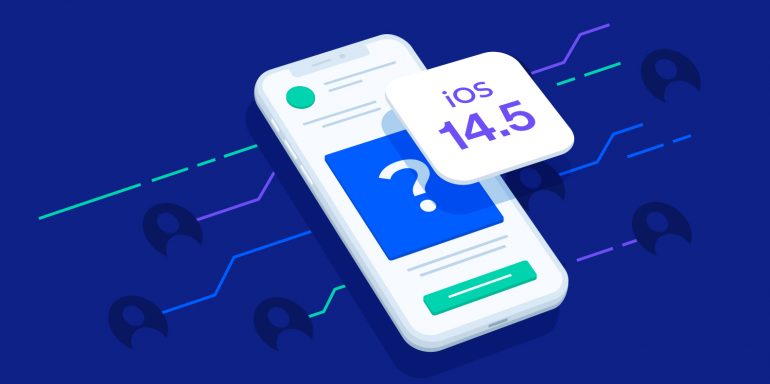Due to growing privacy concerns among consumers, Apple has taken a hard-line approach in its most recent 14.5 update. Now, iOS will require apps to get a user’s permission to track or access consumer data for advertising purposes.
This new feature, called AppTrackingTransparency, has advertisers panicking. Facebook has responded by waging a media campaign against Apple that includes taking out full-page ads in newspapers. The chief concern is that the update will neutralize the effectiveness of digital ads running on iPhones, iPads, and tvOS around the world.
Let’s take a look at what these changes look like and how they might affect your business.
What is AppTrackingTransparency and how does it work?
The update, which Apple rolled out in iOS 14.5, lets users choose whether an advertiser can track their online and in-app activities, as well as gain access to a device’s advertising identifier. App developers must now ask permission to use specific information from other apps and websites for advertising purposes. Every app that tracks user data will require a separate opt-in. Users can go to their settings to see which apps have requested permission to track and can change their choices at any time.
The move is part of Apple’s efforts to give users more control over how apps use their data. “AppTrackingTransparency gives you the choice to share the data that’s being collected about you across apps and websites,” Tim Cook tweeted when the update came out in April.

The feature will not ask users to give permission when activity only occurs on the device, when the data is solely for security purposes such as fraud prevention, or when a consumer reporting agency would share the data.
Should advertisers be worried about iOS 14.5?
It’s too early to know how these changes might affect advertisers, but the impact of the iOS update is likely to be significant. According to Apple’s 2020 Q1 report, there were 1.4 billion active Apple devices worldwide, with 900 million of those devices being iPhones. In the U.S., iPhones represent over 45% of all smartphones. The update could affect conversion rates, page views, cart adds, checkouts, and purchases. Of course, a lot comes down to how many users will choose not to have their data tracked. According to Flurry, which is tracking those numbers, only 6% of iPhone users in the U.S. opted in as of May 13.
But advertisers may rest assured that there are some controls in place. Consider that most people use both desktop and mobile devices to browse the internet. Most users view Facebook ads on iPhones apps, yet the company has been in operation for so long that they’ve already logged and accounted for a massive quantity of user data. Plus, many consumers have grown accustomed to a more personalized ad experience and may choose to have their data tracked.
Research shows that a majority of users prefer ads tailored to their interests and shopping habits.
What can advertisers do to prepare?
Marketers who are worried about declining revenues should stay up to date with information large-scale digital companies are sending out. Many are scrambling to share advice to help advertisers prepare for what’s ahead.
For example, Facebook is regularly communicating to advertisers about what changes they can expect. The company warns that the iOS update will affect the following areas: conversions, domain verification, ads reporting, and targeting. Facebook has created an “Aggregated Event Measurement,” a protocol that’s supposed to help marketers measure how campaigns perform “in a way that is consistent with consumers’ decisions about their data.”
Google says app publishers may see a “significant impact” to their Google Ads revenue and urges developers to upgrade to version 7.64 of the Apple ad-tracking tool, Google Mobile Ads SDK, to ensure they can take advantage of new features, such as SKAdNetwork support. Google is also suggesting that app advertisers upgrade to the latest version of Google Analytics for Firebase to be able to measure ad performance.
How the iOS update impacts use of the Meta pixel
For advertisers using the Meta pixel, a tracking tool used to attribute page visits to their Facebook ad clicks, the iOS update imposes several new limitations, such as:
- Reporting delays of up to three days
- Removal of delivery breakdowns like age, gender, and location
- Maximum of eight conversion events per domain
- Less reliable campaign tracking
- Seven-day default click attribution for new and existing campaigns
Advertisers who rely on the Meta pixel for attribution and tracking will need to find alternative methods of gathering data. Here are some steps marketers can take to brace for possible fallout from the Apple iOS 14.5 update:
- Rely less on the Meta pixel. UTMs and other tactics can help determine which campaign, ad set, and ad resulted in conversion.
- Diversify your traffic sources. Find other ways to connect with customers, like Google, Twitter, TikTok, Snapchat, or Pinterest.
- Emphasize retention. Leverage email and SMS marketing to combat rising customer acquisition costs.
- Verify your business domains. This best practice is a Facebook recommendation and can help you avoid future disruptions.
- Use promo codes and other tools to improve attribution. Adding promo codes to your ads can help you attribute page visits to your mobile ads.
- Focus on areas where you do have control, such as the post-click stage of the ad funnel. Personalized landing pages can improve ROI and lower CPA.
It’s impossible to ignore the iOS 14.5 update, but advertisers can use specific techniques to continue to build personalized ad narratives. If you want to find ways to lower your customer acquisition costs and get better returns, Instapage can help. Our team offers three different plans and pricing options to help you see real results. Check out Instapage pricing plans here.
